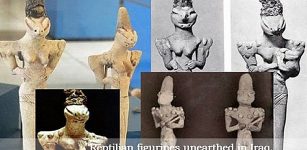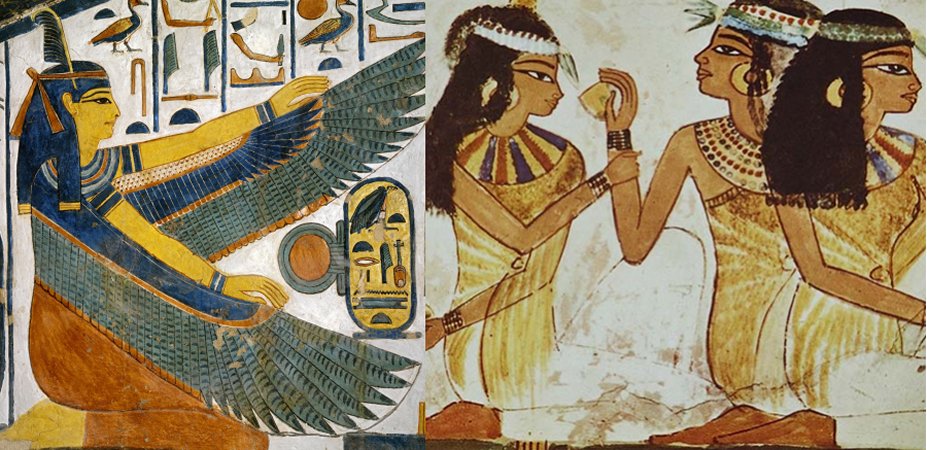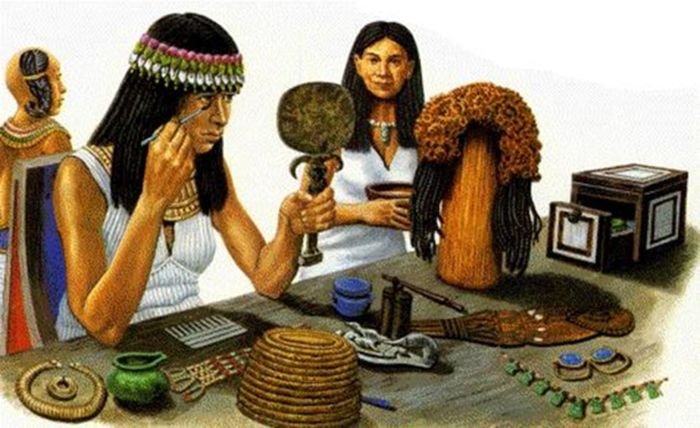Ancient Egyptian Women Had Equal Rights As Men – Egyptian Cosmology And Goddess Maat Reveal Why
Ellen Lloyd - AncientPages.com - When ancient Greek historian Herodotus (484–c. 425 BC) visited Egypt, he was shocked to see how women behaved. Unlike women in ancient Greece, Egyptian females had the same rights as men. They worked, received the same pay rations as men, got drunk, and could become powerful rulers.
Such behavior was completely unacceptable in ancient Greece where women had no rights at all and had to obey the man, who was master of the house.
Ancient Greek women had to receive permission from the man to leave the house’s female quarters. The situation for females in ancient Egypt was much different. In the land of the pyramids, it was not unusual that women spend their days visiting markets and shopping, while their husbands stayed at home doing ordinary housework.
Ancient Egyptian Cosmology And Goddess Maat
Women in ancient Egypt had equal rights as men for thousands of years, but why did their living conditions differ so much from women who lived in neighboring countries?
The answer to this question can be found in Egyptian mythology and ancient Egyptians’ cosmological beliefs.
In ancient Egypt, people worshipped Maat (Ma’at), goddess of truth, balance, and order. Her name, literally, meant ‘truth’ in Egyptian and she was a symbol of harmony. Egyptians believed that without her existence, the universe would become chaos, once again.
As previously mentioned in Ancient Pages, there is a striking similarity between the Ten Commandments and the 42 Principles of Ma’at that appeared at least 2,000 earlier.
The 42 Principles of Ma’at were created so that ancient Egyptians could follow vital rules and act with honor and truth in manners that involve family, the community, the nation, the environment, and the gods.
Goddess Maat. Image credit: blackawakeningmovement.com
Ancient Egyptians viewed the universe as a complete duality of male and female
When the Universe was born there existed a mutual relationship between gods and goddesses. Female gods were just as important as male gods. It was, therefore, necessary to preserve a balance between the gods and people and between the two sexes. Goddess Maat was responsible that this balance was kept.
See also:
Maat – Ancient Egypt’s Most Important Religious Concept
10 Fascinating Facts About Pharaohs
Herodotus believed the Egyptians 'have reversed the ordinary practices of mankind’ and the treatment of women in ancient Egypt caused controversy among other ancient cultures, but the Egyptians kept their laws based on their beliefs.
Divorce, Education, Wills, Inheritance And Same Punishment For Crimes
Egyptian women were allowed to divorce if they were no longer happy with their husbands. Rich Egyptian women could study and get a proper education. This was not possible for women who came from poor families due to financial matters.
Women in ancient Egypt had plenty of rights.
Women and men received the same punishment for the same crime. The property was inherited through the woman's family, and women were able to manage their land, their animals, and their homes themselves. Egyptian females were allowed to make wills and even choose which of their children would inherit.
In another article on Ancient Pages, we discussed the importance of Egyptian makeup. Frescoes discovered in ancient Egyptian temples illustrating daily life reveal men often wore makeup. In fact, it’s almost impossible to find a portrait of an ancient Egyptian whose eyes are not decorated.
The use of cosmetics was vital to men and women in ancient Egypt. Makeup was once an important part of everyday life in Egypt and it was not only used to look better. There was a much more important purpose behind the use of cosmetics in ancient Egypt. Cosmetics was sacred to ancient Egyptians and used not only for aesthetic purposes but rather for magical and religious purposes.
There were no differences between how men and women used makeup.
Pharaoh Hatshepsut and Queen Nefertiti were two famous female rulers in ancient Egypt.
Egyptian women could become powerful pharaohs, but they were naturally challenged by their male rivals. Once a female had become a pharaoh, her duties did not differ from male pharaohs.
A good example of a skillful and efficient female ruler is Pharaoh Hatshepsut, who brought prosperity to ancient Egypt. Another important female ruler was Queen Nefertiti. Why she suddenly disappeared after being elevated to near-equal status by King Akhenaten remains a mystery.
Written by - Ellen Lloyd – AncientPages.com
Copyright © AncientPages.com All rights reserved. This material may not be published, broadcast, rewritten or redistributed in whole or part without the express written permission of AncientPages.com
Expand for referencesMore From Ancient Pages
-
 Amergin: First Druid And ‘Wondrously Born’ Son Of Mil, Founder Of Poetry, Was Judge In Irish Mythology
Celtic Mythology | Mar 3, 2022
Amergin: First Druid And ‘Wondrously Born’ Son Of Mil, Founder Of Poetry, Was Judge In Irish Mythology
Celtic Mythology | Mar 3, 2022 -
 Spread Of Transeurasian Languages Was Due To Agriculture Study Reveals
Archaeology | Nov 10, 2021
Spread Of Transeurasian Languages Was Due To Agriculture Study Reveals
Archaeology | Nov 10, 2021 -
 Ancient DNA Extracted From A 2,900-Year-Old Clay Brick – Unique Time Capsule Of Plant Life
DNA | Aug 23, 2023
Ancient DNA Extracted From A 2,900-Year-Old Clay Brick – Unique Time Capsule Of Plant Life
DNA | Aug 23, 2023 -
 Arachne – Spider Woman Who Challenged Goddess Athena And Was Punished
Featured Stories | Dec 5, 2018
Arachne – Spider Woman Who Challenged Goddess Athena And Was Punished
Featured Stories | Dec 5, 2018 -
 The Indigenous Artists Keeping Ancient Rock Art Traditions Alive For Future Generations
Archaeology | Oct 3, 2024
The Indigenous Artists Keeping Ancient Rock Art Traditions Alive For Future Generations
Archaeology | Oct 3, 2024 -
 Naupa Huaca: The Enigmatic Stone Temple In A Cave In Peru
Featured Stories | Sep 10, 2020
Naupa Huaca: The Enigmatic Stone Temple In A Cave In Peru
Featured Stories | Sep 10, 2020 -
 Fascinating Ancient And Unexplained Mysteries Of Arizona – Secrets Of The Canyons And Mountains – Part 1
Featured Stories | Sep 29, 2024
Fascinating Ancient And Unexplained Mysteries Of Arizona – Secrets Of The Canyons And Mountains – Part 1
Featured Stories | Sep 29, 2024 -
 Medieval Ship Discovered Off The West Coast Of Sweden May Have Been Attacked By Pirates
Archaeology | Feb 4, 2022
Medieval Ship Discovered Off The West Coast Of Sweden May Have Been Attacked By Pirates
Archaeology | Feb 4, 2022 -
 Illuminated Ancient Manuscripts Reflect 1,000 Years Of Human History
Artifacts | Sep 12, 2015
Illuminated Ancient Manuscripts Reflect 1,000 Years Of Human History
Artifacts | Sep 12, 2015 -
 Axum: Mysterious Megalithic Towering Obelisks In Ethiopia
Civilizations | Aug 21, 2018
Axum: Mysterious Megalithic Towering Obelisks In Ethiopia
Civilizations | Aug 21, 2018 -
 The Mystery Of The Serpent Seed
Biblical Mysteries | Jul 19, 2019
The Mystery Of The Serpent Seed
Biblical Mysteries | Jul 19, 2019 -
 Magnificent Pagodas In Indein Village And Undiscovered Secrets In The Myanmar Jungle
Featured Stories | Oct 9, 2020
Magnificent Pagodas In Indein Village And Undiscovered Secrets In The Myanmar Jungle
Featured Stories | Oct 9, 2020 -
 New Genes May Explain Why Humans Got Such Big Brains
Archaeology | Jun 2, 2018
New Genes May Explain Why Humans Got Such Big Brains
Archaeology | Jun 2, 2018 -
 Head Of The Great Sphinx Was Changed – It’s The Gateway To A Secret Underground City– Historians Suggest
Featured Stories | Jan 20, 2018
Head Of The Great Sphinx Was Changed – It’s The Gateway To A Secret Underground City– Historians Suggest
Featured Stories | Jan 20, 2018 -
 Arian Tower: Pyramid-Shaped Mausoleum Of Nobleman Was Built On Top Of Medieval Hill Fort
Archaeology | May 19, 2018
Arian Tower: Pyramid-Shaped Mausoleum Of Nobleman Was Built On Top Of Medieval Hill Fort
Archaeology | May 19, 2018 -
 Can Discovered Algonquian Artifacts Solve Mystery Of The Lost Colony On Roanoke Island?
Archaeology | May 13, 2024
Can Discovered Algonquian Artifacts Solve Mystery Of The Lost Colony On Roanoke Island?
Archaeology | May 13, 2024 -
 Intact 1,800-Year-Old Roman Sarcophagus With Unexpected Treasures Found In France
Archaeology | Sep 26, 2023
Intact 1,800-Year-Old Roman Sarcophagus With Unexpected Treasures Found In France
Archaeology | Sep 26, 2023 -
 Why Did Vikings Carry Decorative Swords That Were Useless In Combat?
Ancient History Facts | Jun 8, 2024
Why Did Vikings Carry Decorative Swords That Were Useless In Combat?
Ancient History Facts | Jun 8, 2024 -
 Wayland The Smith: Legendary Master Blacksmith And Lord Of The Elves
Featured Stories | Jul 14, 2016
Wayland The Smith: Legendary Master Blacksmith And Lord Of The Elves
Featured Stories | Jul 14, 2016 -
 First Carbon-Based Paleolithic Paintings Found In Font-De-Gaume Cave, France Could Be 19,000 Years Old
Archaeology | Dec 29, 2023
First Carbon-Based Paleolithic Paintings Found In Font-De-Gaume Cave, France Could Be 19,000 Years Old
Archaeology | Dec 29, 2023





